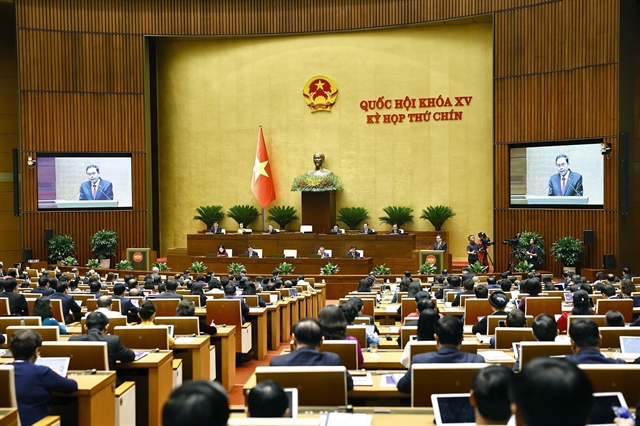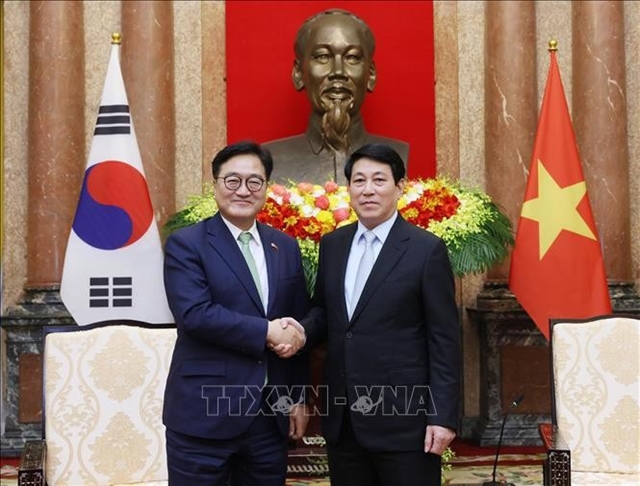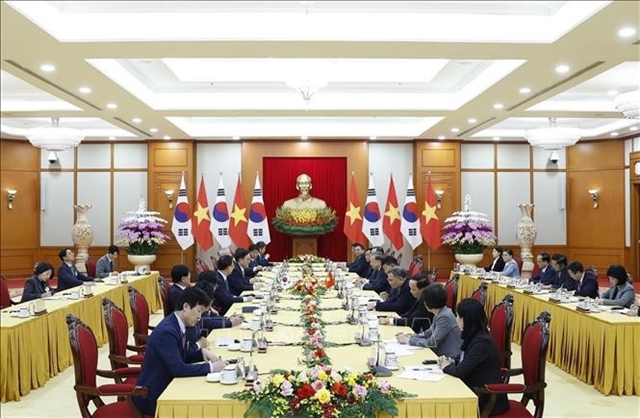 Opinion
Opinion

 |
| NA Chairman Trần Thanh Mẫn delivered the opening speech of the NA's 9th session on May 5, during which the amendment proposal was brought up for discussion. — VNA/VNS Photo |
HÀ NỘI — Việt Nam has begun the process of constitutional amendments to carry out sweeping administrative reforms, including reducing the number of provinces, eliminating district-level governments, as well as reorganising the structure and redefining the role of the Vietnam Fatherland Front (VFF), a key political umbrella organisation.
Here's how the process works and why it matters.
What are the proposed changes?
Việt Nam’s current administrative system is organised into three levels: provincial, district and communal. The constitutional amendments are set to centre on three major changes, affecting eight of the Constitution's 120 articles:
• Provincial mergers: The number of provinces and centrally governed cities, currently at 63, will be reduced to 34 through mergers. This aims to reduce duplicated administrative functions, consolidate resources, and improve economic scale.
• Abolition of district-level governments: Việt Nam plans to eliminate the entire district level, meaning no more districts, towns or provincial cities. Provinces would directly manage communes (villages, wards and townships), creating a two-tier administrative system.
"The three-tier government model has become increasingly cumbersome and duplicative, generating excessive administrative procedures and failing to leverage digital technologies to improve public service delivery," NA Vice Chairman Nguyễn Khắc Định said on May 5 when he initiated the process on behalf of the NA Standing Committee.
• Restructuring the Vietnam Fatherland Front (VFF): The VFF, a political umbrella organisation enshrined in the Constitution, will undergo structural reforms. While it is not slated for abolition, its functions, organisation and constitutional definition will be adjusted to align with the new administrative structure.
"VFF's functions often overlap with those of its member organisations, and in certain localities, the Front has struggled to maintain close ties with grassroots communities and promptly reflect public sentiment," Định added.
The Government estimated that approximately 19,000 legal documents at the central and local levels could be amended. Key laws requiring urgent revision include the Law on the Organisation of Local Governments and the Law on the Vietnam Fatherland Front.
Why does the Constitution need to be changed?
Việt Nam's current Constitution, passed in 2013, stipulates the country’s three-tier administrative structure in Article 110, listing provinces, districts and communes as official administrative units.
Therefore, removing the district level would directly conflict with the Constitution, necessitating a formal amendment.
Similarly, Article 9 explicitly recognises the VFF as the "political base of the people's power", with mandates including national solidarity, supervision, and social feedback. Any redefinition of its status, functions or structure requires constitutional revision.
In contrast, provincial mergers do not require constitutional changes, as the Constitution does not specify the number or names of provinces. These can be adjusted through ordinary legislative procedures — specifically, resolutions of the National Assembly (NA).
What is the official process to amend the Constitution?
Việt Nam's constitutional amendment procedure is set out in Article 120 of the 2013 Constitution and detailed in the Law on Organisation of the National Assembly. The key stages are:
• Proposal initiation: Amendments can be proposed by the President, the NA Standing Committee, the Government, or at least one-third of the NA deputies.
• NA approval to proceed: The NA must approve the proposal with a two-thirds majority to proceed with the drafting of amendments. Without this supermajority, the process cannot advance.
• Formation of a Constitutional Drafting Committee: If the proposal is approved, the National Assembly establishes a special committee to draft proposed changes. The NA Standing Committee nominates the committee members.
• Public consultation: The draft amendments are released for public feedback, allowing citizens, experts and institutions to contribute comments.
• Revisions and finalisation: The committee incorporates public feedback, revises the draft, and prepares a final version to be submitted to the NA.
• Final vote: The NA votes on the final draft. It must be approved by two-thirds of all deputies to pass. The Constitution allows for a referendum, but this is optional.
Has Việt Nam amended its Constitution before?
Việt Nam has had five constitutional revisions: in 1946, 1959, 1980, 1992, and most recently, in 2013. These changes have led to major political or economic shifts, such as the socialist transformation in 1980 or market-oriented reforms in 1992.
In 2001, the NA passed a partial amendment to the 1992 Constitution, adjusting the government structure and enhancing the role of mass organisations.
The amendment in 2025 would restructure the country’s administrative hierarchy, marking a significant departure from the three-level governance that has existed for decades.
What is the Vietnam Fatherland Front, and why does it matter?
The Vietnam Fatherland Front (VFF) is a unique political institution. Formed as a coalition of political and social organisations, it is mandated by the Constitution to represent citizens and social groups, promote national unity, supervise government activity and provide feedback on laws and policies.
The upcoming constitutional revision may redefine the VFF’s functions or reorganise its structure to align with the proposed two-tier administration. Official proposals suggest that Article 9 will be revised to clarify and strengthen the Front’s role within the political system.
Changes might also affect Article 84, potentially abolishing the right of the VFF's member organisations, such as the Trade Union or Farmers' Union, to propose draft legislation. The aim is to concentrate this authority in the VFF's Central Committee.
The timeline
The NA has begun to discuss the amendment proposal at the start of its 9th session on May 5. The NA Standing Committee has appointed a 15-member Constitutional Drafting Committee led by NA Chairman Trần Than Mẫn, comprising representatives from various central agencies and organisations.
Public consultation is planned for one month, from May 6 to June 5. The amendments are mandated to be finalised no later than June 30 and take effect on July 1, 2025.
The constitutional amendments will reshape the country's political-administrative landscape, which has existed for decades, aiming to create a more streamlined and direct system of government and to strengthen the roles of VFF and its constituent organisations. — VNS




